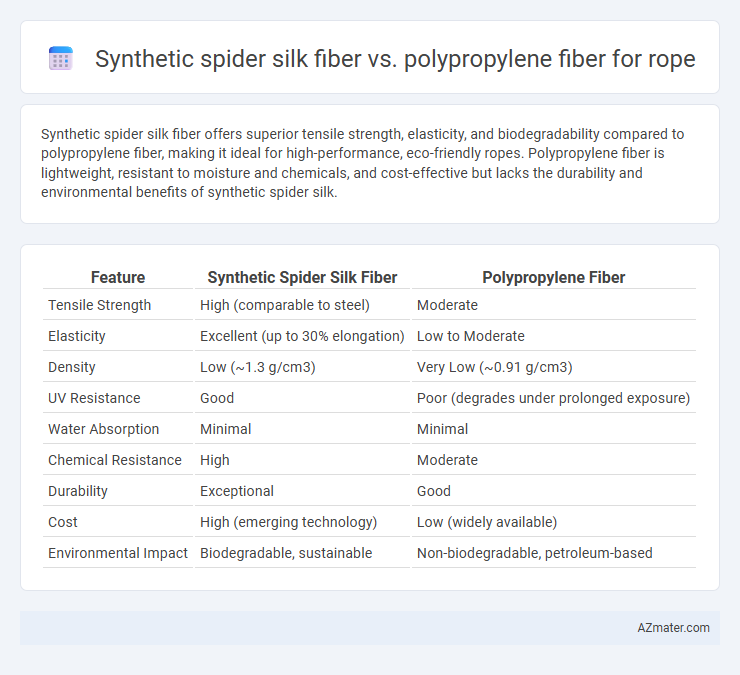Synthetic spider silk fiber offers superior tensile strength, elasticity, and biodegradability compared to polypropylene fiber, making it ideal for high-performance, eco-friendly ropes. Polypropylene fiber is lightweight, resistant to moisture and chemicals, and cost-effective but lacks the durability and environmental benefits of synthetic spider silk.
Table of Comparison
| Feature | Synthetic Spider Silk Fiber | Polypropylene Fiber |
|---|---|---|
| Tensile Strength | High (comparable to steel) | Moderate |
| Elasticity | Excellent (up to 30% elongation) | Low to Moderate |
| Density | Low (~1.3 g/cm3) | Very Low (~0.91 g/cm3) |
| UV Resistance | Good | Poor (degrades under prolonged exposure) |
| Water Absorption | Minimal | Minimal |
| Chemical Resistance | High | Moderate |
| Durability | Exceptional | Good |
| Cost | High (emerging technology) | Low (widely available) |
| Environmental Impact | Biodegradable, sustainable | Non-biodegradable, petroleum-based |
Introduction to Synthetic Spider Silk Fiber and Polypropylene Fiber
Synthetic spider silk fiber is engineered to replicate the exceptional tensile strength, elasticity, and lightweight properties of natural spider silk, making it ideal for high-performance rope applications requiring durability and flexibility. Polypropylene fiber, widely used in rope manufacturing, offers cost-effective, moisture-resistant, and chemical-resistant characteristics but generally lacks the strength and elasticity of synthetic spider silk. The advanced mechanical properties of synthetic spider silk fibers provide superior performance in demanding environments compared to conventional polypropylene ropes.
Material Composition and Structure
Synthetic spider silk fiber consists of protein-based polymers mimicking natural spider silk's beta-sheet crystalline regions and amorphous matrix, providing exceptional tensile strength and elasticity. Polypropylene fiber is a thermoplastic polymer composed of repeating propylene monomers with a semi-crystalline structure, known for its lightweight, chemical resistance, and low moisture absorption. The hierarchical structure of synthetic spider silk offers superior toughness and flexibility compared to the crystalline yet less elastic polypropylene fibers commonly used in industrial rope applications.
Production Methods of Spider Silk vs Polypropylene Fibers
Synthetic spider silk fibers are produced through bioengineering methods involving genetically modified microorganisms or plants that produce silk proteins, which are then spun into fibers mimicking natural spider silk's strength and elasticity. In contrast, polypropylene fibers are manufactured by polymerizing propylene gas into long chains through a process called chain-growth polymerization, followed by extrusion and drawing to form continuous fibers. The production of synthetic spider silk relies heavily on biotechnology and protein synthesis, whereas polypropylene fiber manufacturing is primarily a chemical and mechanical process focusing on thermoplastic polymer extrusion.
Tensile Strength Comparison
Synthetic spider silk fiber exhibits extraordinary tensile strength, reaching up to 1.6 GPa, significantly surpassing polypropylene fiber, which typically ranges between 300 to 600 MPa. The high molecular alignment and beta-sheet crystal structures in synthetic spider silk enable superior elasticity and toughness, making it ideal for high-performance rope applications. In contrast, polypropylene's weaker molecular chains result in lower tensile strength and reduced durability under heavy loads.
Durability and Longevity in Rope Applications
Synthetic spider silk fiber exhibits superior tensile strength and exceptional elasticity compared to polypropylene fiber, significantly enhancing durability in rope applications. Its resistance to UV degradation, moisture, and abrasion ensures longer service life under harsh environmental conditions, outperforming polypropylene fiber's moderate wear resistance. These durability factors make synthetic spider silk fiber ideal for high-stress ropes requiring extended longevity and reliable performance.
Flexibility and Elasticity: Key Differences
Synthetic spider silk fiber exhibits superior flexibility and elasticity compared to polypropylene fiber, enabling ropes made from it to stretch significantly without breaking, which enhances durability and impact resistance. Polypropylene fiber, while economically advantageous and lightweight, has limited elasticity, resulting in lower flexibility and higher susceptibility to permanent deformation under stress. The exceptional tensile strength and elongation properties of synthetic spider silk fibers make them ideal for applications requiring both strength and flexibility, surpassing the performance metrics of traditional polypropylene ropes.
Environmental Impact and Biodegradability
Synthetic spider silk fiber offers superior environmental benefits over polypropylene fiber due to its biodegradability and lower ecological footprint during production. Unlike polypropylene, a non-biodegradable petroleum-based plastic that contributes to long-term pollution and microplastic buildup, synthetic spider silk decomposes naturally without leaving harmful residues. The sustainable sourcing and minimal chemical processing of synthetic spider silk fiber significantly reduce toxic emissions and landfill waste compared to the synthetic polymer-based polypropylene ropes.
Cost Efficiency and Commercial Scalability
Synthetic spider silk fiber offers superior tensile strength and elasticity compared to polypropylene fiber, making it a premium choice for high-performance ropes. However, polypropylene fiber remains more cost-efficient due to its low production costs and widespread commercial scalability, supporting mass manufacturing and availability. While synthetic spider silk shows promise for niche applications, polypropylene dominates the market owing to its affordability and established supply chains.
Performance in Extreme Conditions
Synthetic spider silk fiber exhibits exceptional tensile strength and elasticity, outperforming polypropylene fiber in extreme temperature and humidity conditions. Its superior abrasion resistance and UV stability make it ideal for ropes exposed to harsh outdoor environments, maintaining integrity where polypropylene fibers tend to weaken and degrade. The lightweight yet durable nature of synthetic spider silk enhances safety and longevity in critical applications such as climbing, rescue, and marine use.
Future Prospects and Innovations in Rope Technology
Synthetic spider silk fiber exhibits exceptional tensile strength, elasticity, and biodegradability compared to polypropylene fiber, making it a revolutionary material for future rope technology. Innovations in bioengineering and nanotechnology are driving the development of synthetic spider silk ropes with enhanced durability, lightweight properties, and environmental sustainability. Ongoing research focuses on scalable production methods and multifunctional rope designs to meet the increasing demand for high-performance fibers in aerospace, military, and marine applications.

Infographic: Synthetic spider silk fiber vs Polypropylene fiber for Rope
 azmater.com
azmater.com